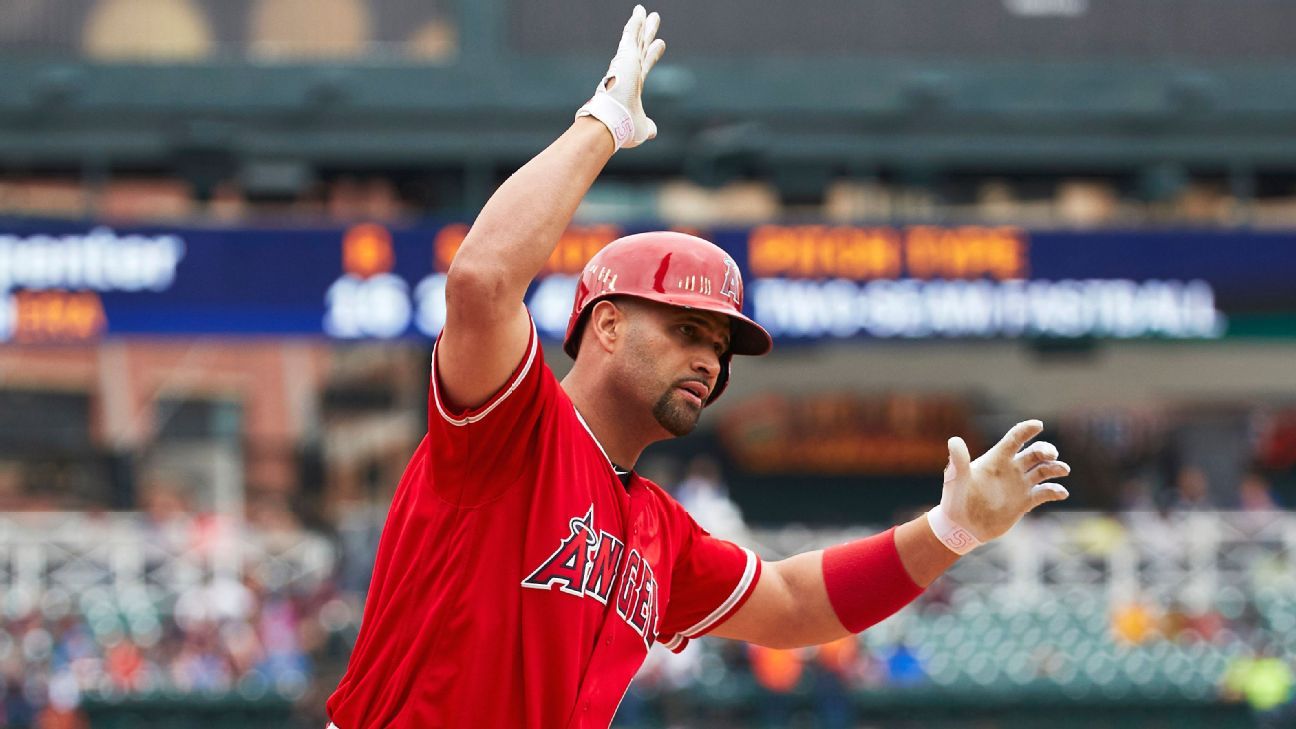There are three old scouting reports of Albert Pujols on the Baseball Hall of Fame website. The first is from a Royals scout named Gary Johnson, filed in November 1998 after Pujols had gone undrafted out of high school in Missouri. This was the most positive of the reports. “Good bat spd. with very strong hands,” Johnson wrote. “Can hit up the middle but tends to pull. Competes well & battles at the plate.” Johnson gave him a future grade of 5 for his hitting and 6 for power and gave him a value of $80,000 and thought him worthy of a pick from Rounds 8 to 10 in the 1999 draft.
The second report is dated March 26, 1999, when Pujols was playing shortstop for Maple Woods Community College in Kansas City. This was from a White Sox scout named John Kazanas. He gave Pujols a 45 grade for future hitting and 75 for power. He predicted a rookie average of .220. “Outstanding power, raw to all fields,” he wrote. “Needs a lot of work w/ set-up approach, shorten stroke, quiet body down during swing — could be drafted higher because of pop. Feel he needs work.” Kazanas apparently didn’t like Pujols’ crouch position in his stance and wrote that he had “loud feet” in the box, whatever that meant.
The third report came in May, from Brewers scout Russ Bove. He gave future grades of 40 for hitting and 55 for power, predicting major league totals of a .240 average with 24 home runs. His value: $20,000. “Aggressive hitter with mistake HR power,” Bove wrote. “Tends to be a hacker. Chases.”
None of those three teams drafted Pujols, of course. The Royals, despite their scout’s $80,000 tag on Pujols, passed on him 17 times before the Cardinals finally took him in the 13th round. Now, don’t go giving the Cardinals too much praise here: They passed on Pujols 15 times before finally selecting him.
In fact, they initially offered Pujols a $10,000 signing bonus. He turned that down and played in the summer amateur Jayhawk League and hit .343. The Cardinals increased their offer to something close to $60,000, and Pujols signed.
His professional career began in 2000 and he had obviously impressed the Cardinals in spring training because he started in the Midwest League. He hit .314 with 19 home runs in the minors. In 2001, slated for Double-A, he instead hit his way on to the big league roster in spring training. He hit .329 with 37 home runs and 130 RBIs as a 21-year-old rookie.
I guess he made the crouch work.
Pujols’ first RBI in the majors came in his fourth game, a two-run home run in the fourth inning off Armando Reynoso of the Diamondbacks. His 2,000th RBI in the majors came on Thursday and it too, fittingly, came on a home run, off Ryan Carpenter of the Tigers in a 13-0 victory for the Angels:
2,000.@PujolsFive | #TheHaloWay pic.twitter.com/ejakVObGXV
— Los Angeles Angels (@Angels) May 9, 2019
Yes, we know Pujols isn’t really helping the Angels much these days — and hasn’t for a few seasons now. He’s hitting .208/.285/.408 and with the return of Shohei Ohtani as the full-time designated hitter, Pujols will be sharing first base with Justin Bour.
Still, we can step away from his current value to the team and appreciate this milestone — and remember what an amazing career Pujols had to get to this point. Since RBIs became an official stat in 1920, Pujols is just the third player to reach 2,000:
Henry Aaron: 2,297
Alex Rodriguez: 2,086
Albert Pujols: 2,000
Barry Bonds: 1,996
Lou Gehrig: 1,994
Babe Ruth: 1,992
Ruth actually topped 2,000 in his career. Baseball-Reference.com, using data from Retrosheet, credits him with 2,214 RBIs. And if you care about 19th century baseball, Cap Anson topped 2,000 as well.
Pujols is tied with A-Rod for most 100-RBI seasons with 14. (Gehrig and Jimmie Foxx had 13.) He topped 100 the first 10 seasons of his career, but this fact is surprising: Pujols never led the majors in RBIs (and he led his league just once, with 118 for the Cardinals in 2010). Here he is year by year:
Pujols has company in this regard: Barry Bonds, Stan Musial (1,950 RBIs) and Eddie Murray (1,917 RBIs) also never led the majors in RBIs.
RBIs, of course, have become widely disparaged in the sabermetric era since they are somewhat context dependent — you need runners on base in front of you to collect a lot of them. Case in point to the anti-RBI argument was Pujols’ own 2017 season, when he hit .241/.286/.386 with 23 home runs but still drove in 101 runs. While he did improve with runners in scoring position (.264/.323/.448), he drove in 100 runs because of his spot in the lineup and his RBI opportunites.
Still, Pujols has been a great RBI man in his career. Check his career splits:
Overall: .301/.381/.552
RISP: .313/.434/.569
Men on: .309/.405/.553
Late & close: .300/.416/.523
High leverage: .316/.414/.567
As those last two numbers indicate, Pujols was pretty good in the clutch. Brad Lidge would certainly agree:
Remember as well that peak Pujols would draw a lot of intentional walks — not as many as peak Bonds, but he is second all time in intentional walks (which were first counted in 1955).
Pujols’ career high in RBIs came in 2006 with 137. He hit .397/.535/.802 with runners in scoring position that year. He finished second in the MVP voting to Ryan Howard … who drove in 12 more runs, apparently enough to sway the MVP voters.
Pujols still managed to win three MVP Awards while finishing second in the voting four times. As the 2,000-RBI milestone reminds us, this was one of the greatest hitters in the history of the game.
